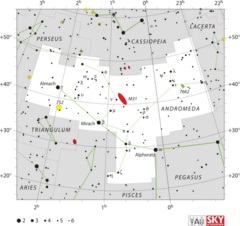Astronomy:Theta Andromedae
| Observation data Equinox J2000.0]] (ICRS) | |
|---|---|
| Constellation | Andromeda |
| Right ascension | 00h 17m 05.50236s[1] |
| Declination | +38° 40′ 53.8886″[1] |
| Apparent magnitude (V) | 4.61[2] |
| Characteristics | |
| Evolutionary stage | main sequence[3] |
| Spectral type | A2 V[4] |
| U−B color index | +0.05[2] |
| B−V color index | +0.06[2] |
| Variable type | Constant[5] |
| Astrometry | |
| Radial velocity (Rv) | 0.9[6] km/s |
| Proper motion (μ) | RA: −57.551(307)[1] mas/yr Dec.: −14.795(155)[1] mas/yr |
| Parallax (π) | 18.8747 ± 0.4251[1] mas |
| Distance | 173 ± 4 ly (53 ± 1 pc) |
| Absolute magnitude (MV) | −0.25[7] |
| Orbit[8] | |
| Period (P) | 1033+91 −77 days |
| Semi-major axis (a) | 25+32 −13 mas |
| Eccentricity (e) | 0.95+0.04 −0.40 |
| Inclination (i) | 69+8 −22° |
| Longitude of the node (Ω) | 263+50 −156° |
| Periastron epoch (T) | 238+343 −143 |
| Argument of periastron (ω) (secondary) | 89+175 −29° |
| Details | |
| A | |
| Mass | 2.83±0.08[3] M☉ |
| Luminosity | 113[7] L☉ |
| Surface gravity (log g) | 3.95[9] cgs |
| Temperature | 8,960[9] K |
| Metallicity [Fe/H] | +0.14[9] dex |
| Rotational velocity (v sin i) | 102[3] km/s |
| Other designations | |
| Database references | |
| SIMBAD | data |
Theta Andromedae is a binary star[11] system in the northern constellation of Andromeda. Theta Andromedae, Latinized from θ Andromedae, is its Bayer designation. It is located at a distance of approximately 173 light-years (53 parsecs) from the Sun,[1] and has an apparent visual magnitude of 4.6.[2] On the Bortle Dark-Sky Scale, this makes it visible to the naked eye from outside urban regions. Based on its motion through space, this system appears to be a member of the Sirius supercluster.[12]
The brighter component is a white hued A-type main-sequence star with a stellar classification of A2 V.[4] It is one of the least photometrically variable stars known.[5] The star shows a high rate of rotation with a projected rotational velocity of 102 km/s.[3] It has an estimated 2.8[3] times the mass of the Sun and is radiating 113[7] times the Sun's luminosity from its photosphere at an effective temperature of 8,960 K.[9] The relatively high chemical abundances of iron and heavier elements suggests it may be a fast rotating Am star.[5]
A stellar companion was detected in 1986 and reported in 1989.[13] This fainter companion is separated from Theta Andromedae by 0.06 arcseconds.[11] The secondary appears to be a massive, possibly A-type, star orbiting at a distance of around one astronomical unit with a period of 2.83 years and a large orbital eccentricity (ovalness) of 0.95.[8]
Naming
In Chinese, 天廄 (Tiān Jiù), meaning Celestial Stable, refers to an asterism consisting of θ Andromedae, ρ Andromedae and σ Andromedae. Consequently, the Chinese name for θ Andromedae itself is known as 天廄一 (Tiān Jiù yī, English: the First Star of Celestial Stable.)[14]
References
- ↑ Jump up to: 1.0 1.1 1.2 1.3 1.4 1.5 Brown, A. G. A. (2021). "Gaia Early Data Release 3: Summary of the contents and survey properties". Astronomy & Astrophysics 649: A1. doi:10.1051/0004-6361/202039657. Bibcode: 2021A&A...649A...1G. Gaia EDR3 record for this source at VizieR.
- ↑ Jump up to: 2.0 2.1 2.2 2.3 Johnson, H. L. et al. (1966), "UBVRIJKL photometry of the bright stars", Communications of the Lunar and Planetary Laboratory 4 (99): 99, Bibcode: 1966CoLPL...4...99J.
- ↑ Jump up to: 3.0 3.1 3.2 3.3 3.4 Zorec, J.; Royer, F. (2012), "Rotational velocities of A-type stars. IV. Evolution of rotational velocities", Astronomy & Astrophysics 537: A120, doi:10.1051/0004-6361/201117691, Bibcode: 2012A&A...537A.120Z.
- ↑ Jump up to: 4.0 4.1 Cowley, A. et al. (April 1969), "A study of the bright A stars. I. A catalogue of spectral classifications", Astronomical Journal 74: 375–406, doi:10.1086/110819, Bibcode: 1969AJ.....74..375C.
- ↑ Jump up to: 5.0 5.1 5.2 Koçer, D. et al. (2003), "Elemental abundance analyses with DAO spectrograms-XXVII. The superficially normal stars θ And (A2 IV), ϵ Del (B6 III), ϵ Aqr (A1. 5 V), and ι And (B9 V)", Astronomy & Astrophysics 406 (3): 975–980, doi:10.1051/0004-6361:20030620, Bibcode: 2003A&A...406..975K.
- ↑ Evans, D. S. (June 20–24, 1966), "The Revision of the General Catalogue of Radial Velocities", in Batten, Alan Henry; Heard, John Frederick, Determination of Radial Velocities and their Applications, Proceedings from IAU Symposium no. 30, 30, University of Toronto: International Astronomical Union, p. 57, Bibcode: 1967IAUS...30...57E.
- ↑ Jump up to: 7.0 7.1 7.2 Anderson, E.; Francis, Ch. (2012), "XHIP: An extended hipparcos compilation", Astronomy Letters 38 (5): 331, doi:10.1134/S1063773712050015, Bibcode: 2012AstL...38..331A.
- ↑ Jump up to: 8.0 8.1 Goldin, A.; Makarov, V. V. (September 2006), "Unconstrained Astrometric Orbits for Hipparcos Stars with Stochastic Solutions", The Astrophysical Journal Supplement Series 166 (1): 341–350, doi:10.1086/505939, Bibcode: 2006ApJS..166..341G.
- ↑ Jump up to: 9.0 9.1 9.2 9.3 Hill, G. M. (February 1995), "Compositional differences among the A-type stars. 2: Spectrum synthesis up to V sin i = 110 km/s", Astronomy and Astrophysics 294 (2): 536–546, Bibcode: 1995A&A...294..536H.
- ↑ "tet And". SIMBAD. Centre de données astronomiques de Strasbourg. http://simbad.u-strasbg.fr/simbad/sim-basic?Ident=tet+And.
- ↑ Jump up to: 11.0 11.1 Eggleton, P. P.; Tokovinin, A. A. (September 2008), "A catalogue of multiplicity among bright stellar systems", Monthly Notices of the Royal Astronomical Society 389 (2): 869–879, doi:10.1111/j.1365-2966.2008.13596.x, Bibcode: 2008MNRAS.389..869E.
- ↑ Palous, J.; Hauck, B. (July 1986), "The Sirius supercluster", Astronomy and Astrophysics 162: 54–61, Bibcode: 1986A&A...162...54P.
- ↑ McAlister, Harold A. et al. (February 1989), "ICCD Speckle Observations of Binary Stars. IV. Measurements During 1986-1988 from the Kitt Peak 4-m Telescope", Astronomical Journal 97: 510, doi:10.1086/115001, Bibcode: 1989AJ.....97..510M.
- ↑ (in Chinese) AEEA (Activities of Exhibition and Education in Astronomy) 天文教育資訊網 2006 年 5 月 18 日
External links
 |


